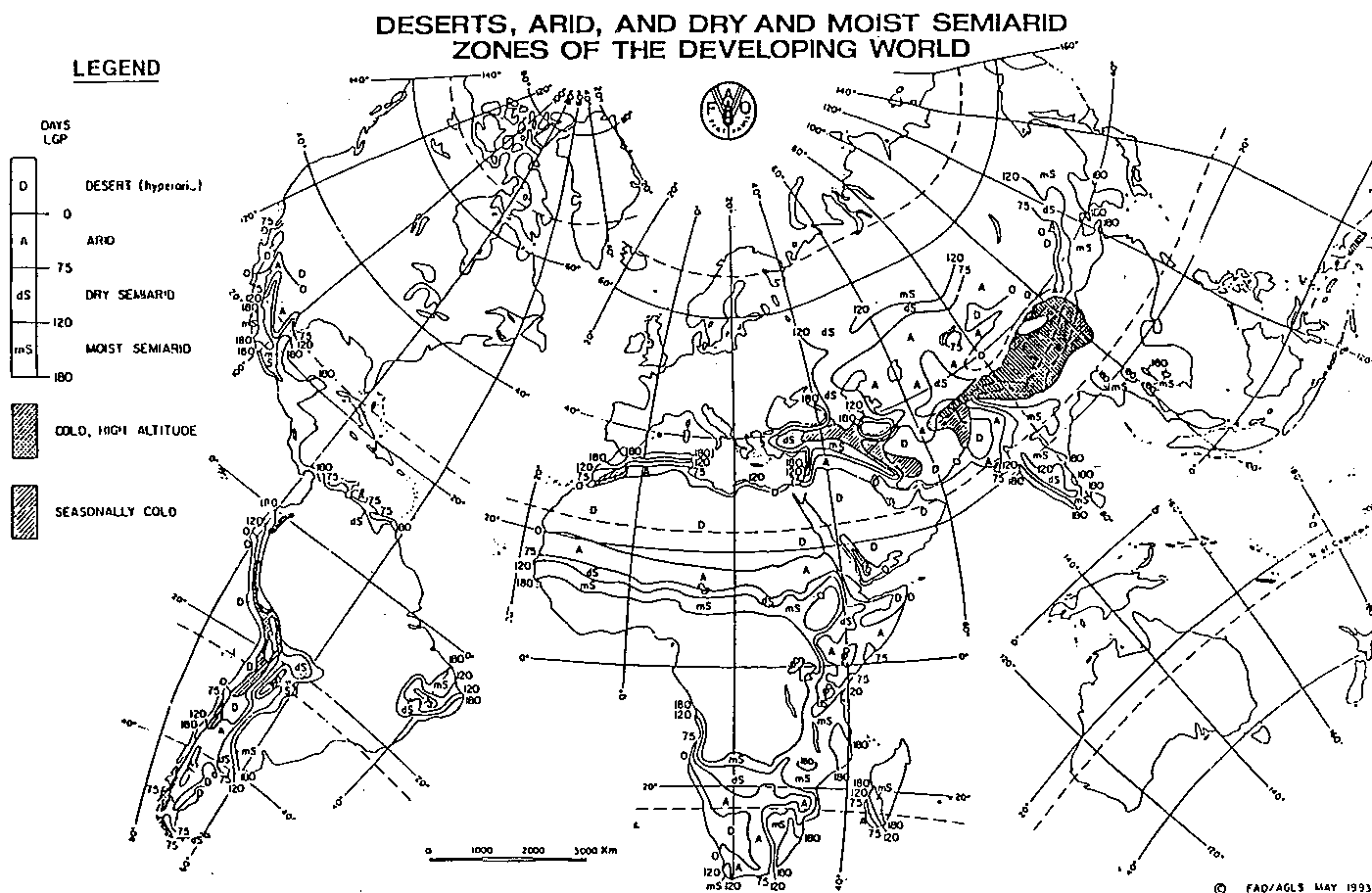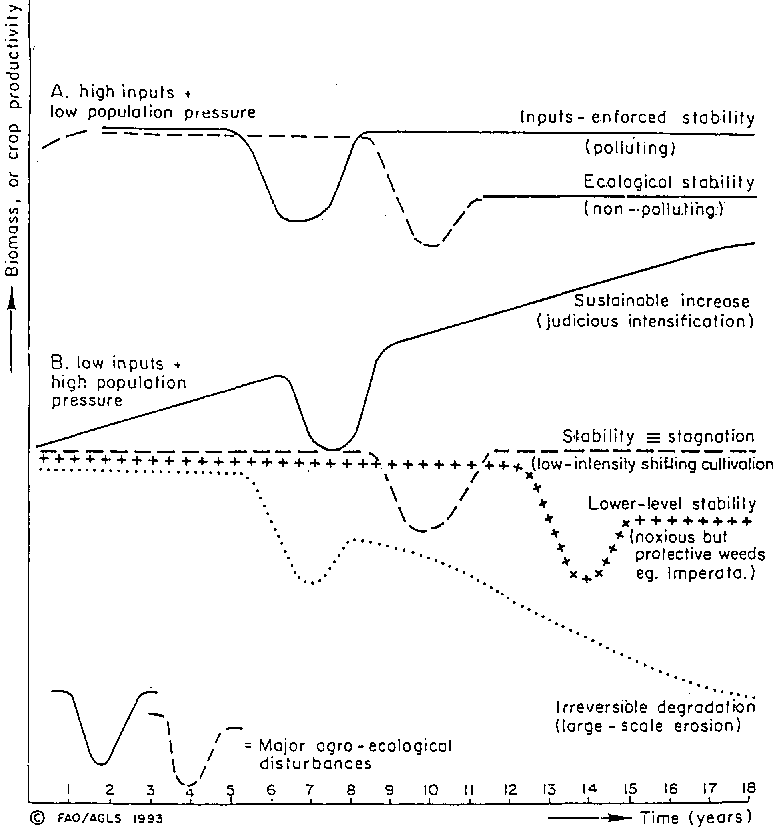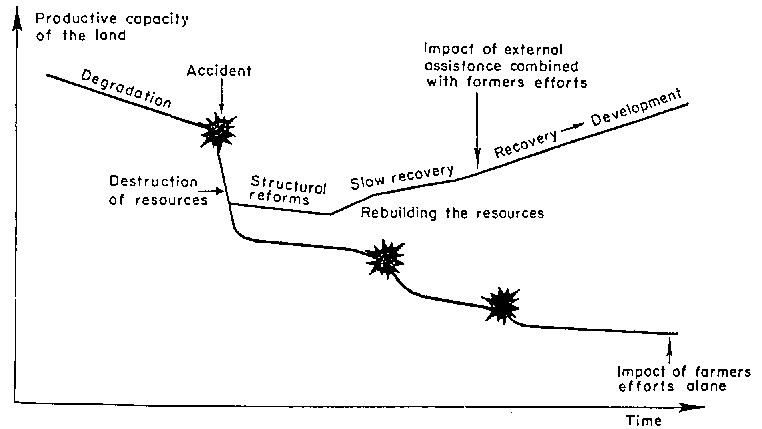a. The fight against desertification is a fight for survival. It is an integral part of socio-economic development programmes which should aim at sustainable agricultural and rural development (SARD).
According to the definition of Sustainable Agricultural and Rural Development approved by the FAO Council in 1988, sustainable development is the management and conservation of the resource base. and the orientation of technological and industrial change in such a manner as to ensure the attainment and continued satisfaction of human needs for present and future generations. Such sustainable development conserves land, water, plant and animal genetic resources, is environmentally non degrading, technically appropriate, economically viable and socially acceptable.
Combating desertification in drylands needs a holistic approach to agriculture, livestock, pastures, woodlands, land settlement and energy policies, taking into account the rehabilitation of the entire affected area, where integration of soil, water, pastures, woodland and wildlife has to be considered, and preferably at a watershed scale, in giving priority to socio-economic and cultural aspects of the inhabitants of the drylands.
More specific to the strategic objective of combating desertification, the sustainable development of arid, semi-arid and dry subhumid zones must confront three challenges:
(i) to check or prevent desertification on land slightly or not degraded by preventive measures;
(ii) to regenerate the productivity of moderately degraded land by corrective measures;
(iii) to restore the productivity of seriously degraded land by rehabilitation and repair measures.
Although the situation and degree of gravity vary substantially by country, its seems that land in the seriously degraded category is fortunately limited in surface area. As a result, the first two categories, where the majority of people affected by desertification live should be the subject of special care and priority. However, the severely degraded lands should not be neglected.
b. If, in the future, human requirements in drylands are to be
met in a sustainable manner, it is now essential to move towards
more efficient use of land and its natural resources.
Integrated land use planning and management is a compulsory way
to achieve this.
c. As human activity is the reason for degradation of drylands in most cases, it is absolutely essential to question the general policies that allow and sometimes cause these actions and operate needed reorientations incorporating sustainability concerns.
In this context, approach to sustainable agriculture and rural development should be inspired by considerations of human needs, poverty alleviation and the creation of production incentives. development should ensure the attainment of three essential goals:
- food security, by ensuring an appropriate and sustainable balance between self sufficiency and self-reliance;
- employment and income generation in rural areas, particularly to eradicate poverty; and
- natural resources conservation (soil, water, natural vegetation) and environmental protection.
d. At the national level different pathways can be chosen for the attainment of SARD, depending on the resource endowments of a country, the existing environmental constraints, the demographic situation and trends, the needs, traditions, the available technologies and human skills. But the first prerequisite is to create a policy framework at national and international levels which is favourable to SARD.
Three major objectives should guide the choice of options for appropriate sector policy development plans and programmes:
(i) Improving efficiency in agriculture and rural development.
(ii) Increasing resilience and minimizing risks in order to reduce the vulnerability of the agriculture sector and the producer to adverse external factors (environmental and socio-economic); and in particular, provide a steady income to the producer and regular supply to the consumer.
(iii) Promoting diversity which generally increase the resilience of production systems minimize risks and provide opportunities for the more efficient diversity of the environment, local resources and cultures.
The attainment of the above-mentioned objectives requires a number of parallel actions at government, rural community, and production unit levels. The main elements which may compose the national strategies are the following:
(i) People's participation and development of human resources;
(ii) Integrated production system management and diversification of rural incomes;
(iii) Improving efficiency and reducing the risks in the use of natural resources:
- land-use planning and soil conservation;
- improved water management;
- conservation and use of genetic resources (plant and animal).
(iv) Ensuring a balanced development and conservation through the use of key inputs for SARD by:
- integrated plant nutrition systems;
- integrated pest management;
- integrated rural energy development and utilization.
(v) Focusing on critical areas such as: drylands and other areas obtain rainfall, irrigated lands; mountain and hilly areas.
e. Political will for sustainable rural development in drylands is a prerequisite.
f. The challenge of overcoming poverty and translating the SARD concept into an operational reality is a common responsibility that should be met at local, national, regional and international levels.
Consequently:
* Improvement of information and monitoring should concern data acquisition systems as well as analysis of communication methods of the final product and the information needs are greatest and more urgent at national and local level.
* The village-based approach (living area of a rural community) is best suited to the necessity of undertaking global actions on the lands (instead of sectorial activities often doomed to failure) with the full participation of the local people.
* Desertification control can only be successful if the social, economic, cultural and political development adopted, aims principally at solving problems brought about by insufficient food, accommodation, employment, income, health, education and population pressure.
* Within the framework of an integrated and rural development policy desertification could be combated. This requires a review of the agricultural development policies and planning in order to integrate anti-desertification programme at national level in the framework of policy formulation and strategic planning. The required strengthening of institutional capacities needed in the rural sector should take account of this integration rather than supporting the setting-up of new institutions and structures.
* Food security is one of the basic strategies of sustainable rural and agricultural development policy, especially in arid, semi-arid and dry subhumid zones.
* The main guiding principle in sustainable development and combating desertification is the promotion of voluntary and responsible popular participation through legislative, economic and institutional measures.
Fig 1.

Fig. 2 Some concepts of resilience of land and its productivity, comparing the situation in some industrialised countries (A) with that of most developing countries (B).

Fig. 3 Adaptation of external to the type of emergency situations (modified from Angé 1990) (1)

Fig. 3 Adaptation of external to the type of emergency situations (modified from Angé 1990) (2)

Fig. 4 Landscape-related nutrient dynamics in mixed farming system
